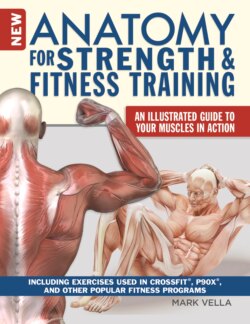Читать книгу New Anatomy for Strength & Fitness Training - Mark Vella - Страница 9
На сайте Литреса книга снята с продажи.
Foreword to the New Edition
ОглавлениеWhen I wrote the original edition of Anatomy for Strength and Fitness Training in 2004, it was a hit, with close to 200,000 copies sold and translated into 9 languages. Since then, the world of fitness and exercise has been radically and beautifully disrupted and transformed by two forces: millennials and technology.
Whether you are a millennial or not, you may find yourself impacted and involved with many of the following exercise landscape changes.
If you are a millennial, born between 1980 and 2000, you make up a quarter of the US population, representing over $200 billion in annual buying power. In 10 years, you will comprise the majority of the economically active workforce. You have radically different values than your predecessors, Generation X. You have shuffled the cards on health and fitness and driven forward new trends through your non-traditional choices. You seek holistic, personalized workouts that are convenient, fun, and fueled by technology.
As a millennial, you have made fitness and wellbeing a bigger priority than any previous generation in post-war times. A 2013 report by the International Health, Racquet and Sportsclub Association states that 27% of millennials aged 21–30 belonged to a fitness club, a higher percentage than any other age group.
You are no longer content to simply accept marketing information driven through the mass media. In nutrition, this disruption is quite evident. Though you still want convenience and economy, as fans of low carb and Paleo eating, you seek organic, local, and artisanal food, and are prepared to pay more for it.
For you, holistic wellness takes precedence over more superficial values. You have eschewed the obsession over weight loss and challenged body image stereotypes. Quality of life, longevity, and feeling good take precedence over the obsession of looking good. Ultimately, you think of wellness as a lifestyle pursuit.
And so, instead of talking about work-life balance, you now talk of work-life integration. You look for working and living environments that embrace wellness as a norm. You take support from Google, coaches, and mentors for your self-empowerment.
As the first fully tech-savvy generation, you are fast-paced learners who like instant feedback and real-time measurement. You have adopted wearable technology like activity trackers and smart watches. You are more likely than any other generation to track your steps, heart rate, and caloric intake through these technologies and then use compatible apps to create personalized diet and exercise regimens.
As millennials, you have shifted spending from long-term assets to more meaningful, personalized lifestyle experiences. And this requirement for personalization, flexibility, and convenience can be seen in all aspects of your wellness lifestyle. Driven initially by Pilates and CrossFit, you began to seek out smaller group classes in smaller studios, closer to home or work, or even online, on-demand workouts from services such as Yoga Anytime or Zumba. You prefer exercise regimens that are individualized and varied to your needs, and, given your overscheduled life, that are shorter and more intense.
You have embraced the “gamification” of everything, from apps that gamify wellness goals to real life game-play in your exercise to increase the fun factor, such as obstacle racing like Tough Mudder or fun runs like The Color Run.
Even though steady-state cardio workouts may be the most effective way to lose weight, the traditional treadmill doesn’t appeal to you. Because of this, you have flocked to workouts that continually vary and/or use high-intensity interval training (HIIT), such as Orangetheory, Zumba, SoulCycle, and CrossFit.
The Sports & Fitness Industry Association’s recent annual report found that you are more likely to partake in physical activity that is more focused on community instead of competition. The cultures and fitness communities you support are reflected in your personal style and social media. This has driven the tribal group “#fitfam” culture as found at SoulCycle or CrossFit.
Given this radical change in the landscape, I was thrilled when I was asked to update this book. It was time to completely shift the book and its message toward a new, informed generation who embrace functional, multimode, compound training. Thank you to Colleen Dorsey and the team at Fox Chapel for embracing the new vision, and seeing the value in going beyond the original scope.
I have had the privilege of teaching movement anatomy for nearly 30 years now, having worked with close to 3,000 students and clients in the wellness and exercise domain. I thank all of you. May it never end.
My invitation to you, the reader, is simple: use this book. For entertainment, to be educated, and to empower yourself. Work with it. Refer to it. Let it inspire you to be a better you. Happier, stronger, and more positive, with something to contribute to this world.
Yours in health,
Dr. Mark Vella, ND (Naturopathic Doctor) MAY 2017
